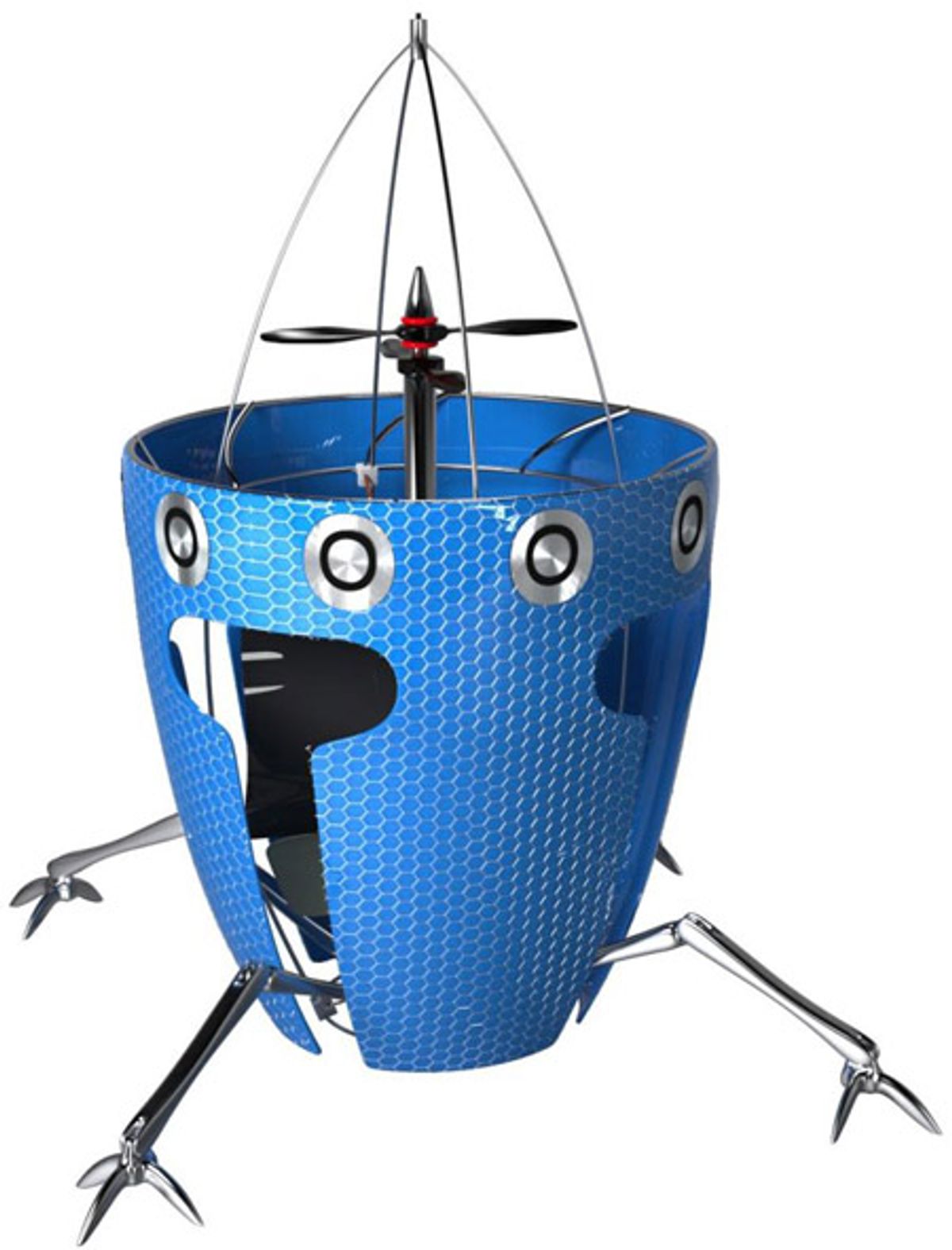In October of 2009, we wrote about the very first version of EPFL's AirBurr micro air vehicle, called HoverMouse. It was an innovative design: a roll cage protected the MAV's engine and flight surfaces, enabling it to crash into walls and floors without damage and then take off again, provided it had enough room to get airborne. Seven iterations later, the AirBurr V8 Samurai includes an active self-righting mechanism that allows it to crash and take off again even in rugged and cluttered environments.
AirBurr's latest trick involves first crashing into something and falling to the ground, which I imagine was a pretty easy thing to get it to do. Second, the MAV rolls over onto its side thanks to a clever arrangement of carbon fiber caging plus a carefully designed center of gravity. Third, AirBurr activates an "Active Recovery System" consisting of carbon fiber legs that deploy out from the body, pushing the body of the MAV into a vertical position from which it can lift off straight up. Watch:
Overall, this system is sort of like a cross between a WeebleCopter and that nifty little jumping robot that can self-right after landing.
The big advantage that AirBurr has is that it doesn't have to be super clever apart from the structural design. This isn't to say that the robot isn't clever, but what makes it clever is that it doesn't have to localize, it doesn't have to detect objects, and it doesn't have to rely on all kinds of sensors and onboard computing power. Instead, it can just smash into things and recover and keep on going. As the video points out, this is a very insect-like behavior, and AirBurr is ideal for confined and cluttered environments that are bad for traditional sensors, like disaster areas or anywhere indoors or underground.
According to a forthcoming paper in IEEE Transactions on Robotics (authored by Adam Klaptocz, Ludovic Daler, Adrien Briod, Jean-Christophe Zufferey, and Dario Floreano), the AirBurr Samurai was able to autonomously right itself within 25 seconds in 100% of the time after being manually knocked over on a flat surface. The robot had a little bit of trouble trying to get back up after landing on slopes greater than 10 degrees, and gravel and rocks proved tricky as well. Part of the problem is the autonomous controller, and EPFL researchers are already working on the AirBurr V9, which will be even smarter:
The active uprighting mechanism described in this paper is a first mechanical implementation that could be extended through improved sensing and control. Initial investigations show that lightweight strain gauges integrated into the legs can measure the shape of the leg and, thus, the force it provides at its tip. Further, strain gauges can measure tension in the string and, thus, contact with obstacles. Such information can be leveraged to create a more intelligent controller that can extract the platform from ever more complex situations.
Now, as we've mentioned, the Samurai is the 8th generation of the AirBurr. Just for fun, here's the whole lineup, dating back to 2009:
AirBurr V1 "HoverMouse": The first prototype of the AirBurr, weighing only 25g, and featuring a gravity-based self-recovery system which allows it to return to a takeoff position after a collision.
AirBurr V2 "ICRA2010": As its namesake may suggest, "ICRA2010" is a modified version of AirBurr V1 "HoverMouse" built for publication at the IEEE International Conference on Robotics and Automation. The main improvements include the use of 3D-printed connection points between the carbon fibre rods to increase repairability.
AirBurr V3 "Flying Stick": "Flying Stick" is the first AirBurr prototype to feature embedded sensing in the form of the BurrSens V3 Inertial Measurement Unit (IMU). It is capable of autonomous hovering flight stabilization.
AirBurr V4 "Crashy": "Crashy" was designed to test improved collision energy absorption techniques. It uses deflecting carbon-fibre beams and rods to absorb the energy of head-on collisions.
AirBurr V5 "Bumpy": "Bumpy" is the first prototype to have a sense of touch thanks to force sensors strategically placed inside the carbon fibre structure. The signals from these sensors are analyzed using an embedded algorithm and can detect the position and amplitude of a force on its outer ring to an accuracy of around 0.5 N and 10 degrees.
AirBurr V6 "Sticky": "Sticky" is the first attempt at using gecko-inspired dry adhesives to attach to smooth surfaces such as windows.
AirBurr V7 "Multitasky": "Multitasky" is a platform used for experiments in robust orientation stabilization. It is the first AirBurr platform to have altitude stabilization using an ultrasonic distance sensor.
AirBurr V8 "Samurai": "Samurai" is the first flying robot to feature an active self-recovery mechanism, allowing it to return to an upright position and take off after a collision, no matter how it lands on the ground. The mechanism has been successfully tested in a variety of environments ranging from hardwood to gravel to rocks.
Thanks Markus!
Evan Ackerman is a senior editor at IEEE Spectrum. Since 2007, he has written over 6,000 articles on robotics and technology. He has a degree in Martian geology and is excellent at playing bagpipes.












